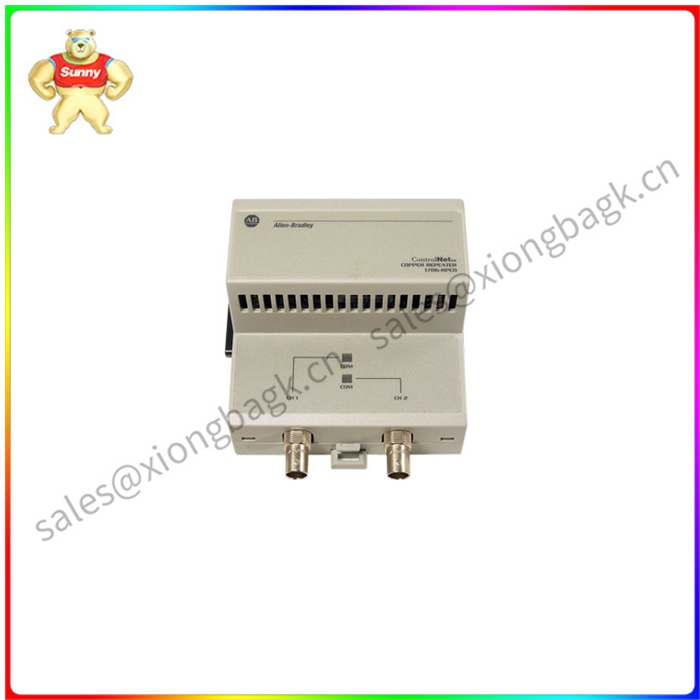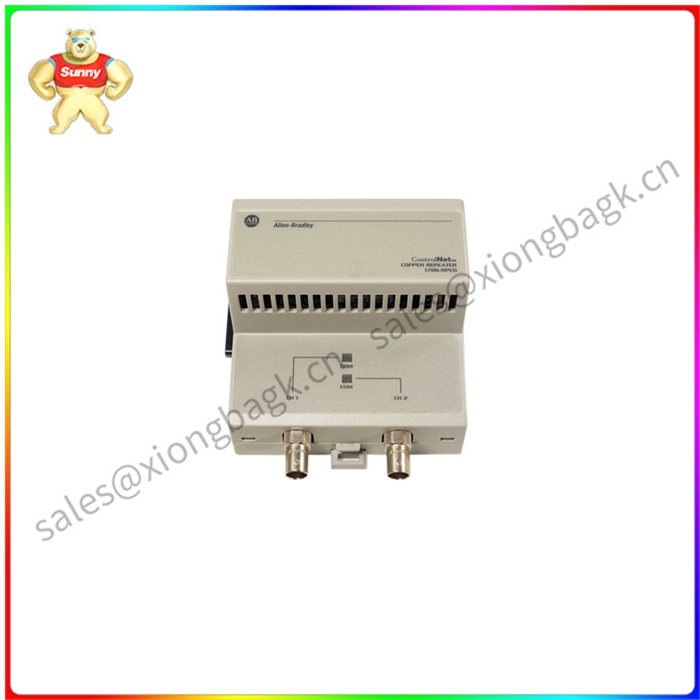1786-RPCD 带有两 (2) 个 ControlNet 同轴(铜缆)端口
1786-RPCD 是 Allen-Bradley 的 ControlNet 中继器模块。该模块主要用于扩展现有的 ControlNet 网络。此中继器模块与目录号为 1786-RPA/B 的中继器适配器一起使用,zui多可以安装四 (4) 个 1786-RPCD 和一个中继器适配器。1786-RPCD 带有两 (2) 个支持 RG6 同轴电缆的 ControlNet 端口。通过双 ControlNet 端口,该适配器模块可用于在线性、星形和冗余拓扑中扩展 ControlNet 网络。除了上述拓扑结构外,1786-RPCD 还用于基于集线器的 ControlNet 网络,以实现更长的 ControlNet 距离覆盖范围并实现隔离的 ControlNet 网段。未使用的端口通道必须插入 75 欧姆干线端接电阻器,其 Allen-Bradley 目录号为 1786-XT。1786-RPCD 从中继器适配器模块接收电源。它在 5VDC 时的背板电流消耗为 400 mA,zui大功耗为 2 瓦,功耗为zui大 2 瓦。它有一个开放式外壳,因此该模块应安装在外壳内,以提供足够的工业元素保护。该模块的工作温度为 0-60 摄氏度。1786-RPCD 有两 (2) 个 LED 状态指示灯,例如通道 1 和通道 2 指示灯。当模块运行时,LED 呈绿色亮起,活动通信通道的 LED 呈绿色闪烁。该模块尺寸为 4.048 英寸或 101.2 毫米(高度);4.44 英寸或 111 毫米(宽度)和 2.76 英寸或 69 毫米(深度)。它安装在标准的 35 mm DIN 导轨上。
1786-RPCD 是 Allen-Bradley 制造的同轴中继器模块控制网。1786-RPCD 同轴中继器模块连接到为其提供 5 伏直流电的 RPA/B 中继器适配器,在zui大 5 伏直流电时,背板电流消耗为 400mA。1786-RPCD 旨在扩展网络长度,提供点对点拓扑,或执行从同轴介质到光纤介质的网络介质转换,反之亦然。1786-RPCD 的工作温度为 32 至 140 华氏度,非工作温度为 60 度,用于根据 IEC 61000-4-5 标准进行射频抗扰度。它在 10 至 500 赫兹时具有 5g 的振动,非冷凝湿度的相对湿度范围为 5% 至 95%。1786-RPCD 由中继器适配器供电。1786-RPCD 可以轻松地将多个 1000 米铜段连接到单个中继器适配器 (1786-RPA)。它为每个通道提供两个铜缆通道和活动状态指示器。1786-RPCD 由两个状态指示器组成,操作员通过解释这些指示器来传达故障情况以及是否通电,包括模块获取的数据是否存在故障。其延迟值为100ns。安装 1786-RPCD 时,请将 1786-RPCD 模块以 30 度角放置。将模块背面的唇部钩到 DIN 导轨的顶部,然后将其旋转到轨道上。然后将模块按到 DIN 导轨上,直到出现齐平。同时,锁定片应卡入正确的位置并将模块锁定到 DIN 导轨上。必要时,将模块向左滑动以与中继器适配器或其他中继器模块连接。插入或取出模块时要注意观察。不建议在通电的情况下拆卸或添加 1786-RPCD 模块。进入和断开时应关闭电源,并应确定该区域为无危险区域。1786-RPCD 适用于网络中需要基于集线器的拓扑,并且网段需要更长的铜线距离;网络设计需要一个单独的部分,节点的数量也需要中继器。

1786-RPCD 带有两 (2) 个 ControlNet 同轴(铜缆)端口
1786-RPCD is the ControlNet repeater module for Allen-Bradley. This module is primarily used to extend the existing ControlNet network. This repeater module is used with a repeater adapter with directory number 1786-RPA/B and can be installed with up to four (4) 1786-RPcds and one repeater adapter. The 1786-RPCD comes with two (2) ControlNet ports supporting RG6 coaxial cable. With dual ControlNet ports, this adapter module can be used to extend ControlNet networks in linear, star, and redundant topologies. In addition to the above topology, the 1786-RPCD is also used in the ControlNet network based on hubs to achieve longer ControlNet distance coverage and to achieve isolated ControlNet network segments. Unused port channels must be plugged into a 75 ohm mainline terminating resistor with Allen-Bradley catalog number 1786-XT. 1786-RPCD Receives power from the relay adapter module. It has a backplane current consumption of 400 mA at 5VDC, a maximum power consumption of 2 watts and a maximum power consumption of 2 watts. It has an open housing, so the module should be installed inside the housing to provide adequate protection from industrial elements. The module operates at a temperature of 0-60 degrees Celsius. The 1786-RPCD has two (2) LED status indicators, such as channel 1 and Channel 2 indicators. When the module is running, the LED lights up green and the LED of the active communication channel flashes green. The module measures 4.048 inches or 101.2 mm (height); 4.44 inches or 111 mm (width) and 2.76 inches or 69 mm (depth). It is mounted on a standard 35 mm DIN rail.
The 1786-RPCD is a coaxial repeater module control network manufactured by Allen-Bradley. The 1786-RPCD coaxial repeater module is connected to the RPA/B repeater adapter that supplies it with 5 volts of DC, and the backplane current consumption is 400mA at a maximum of 5 volts of DC. The 1786-RPCD is designed to extend network length, provide point-to-point topology, or perform network media conversion from coaxial media to fiber media, and vice versa. The 1786-RPCD has an operating temperature of 32 to 140 degrees Fahrenheit and a non-operating temperature of 60 degrees for RF immunity according to IEC 61000-4-5 standards. It has a vibration of 5g at 10 to 500 Hz and a relative humidity range of 5% to 95% for non-condensing humidity. The 1786-RPCD is powered by a repeater adapter. The 1786-RPCD can easily connect multiple 1000m copper segments to a single repeater adapter (1786-RPA). It provides two copper channels and activity status indicators for each channel. The 1786-RPCD consists of two status indicators, which are interpreted by the operator to communicate failure conditions and whether power is on, including whether there is a fault in the data acquired by the module. Its delay value is 100ns. When installing the 1786-RPCD, place the 1786-RPCD module at a 30 degree Angle. Hook the lip on the back of the module to the top of the DIN rail, then rotate it onto the track. Then press the module onto the DIN rail until it appears flush. At the same time, the locking disc should snap into the correct position and lock the module to the DIN rail. If necessary, slide the module to the left to connect to the repeater adapter or other repeater modules. Observe when inserting or removing modules. It is not recommended to remove or add the 1786-RPCD module with power on. The power supply should be turned off when entering and disconnecting, and the area should be determined as a no-danger area. The 1786-RPCD is suitable for networks that require concentrator-based topologies and where network segments require longer copper wire distances; The network design requires a separate section, and the number of nodes also requires Repeaters.






 QQ在线客服
QQ在线客服